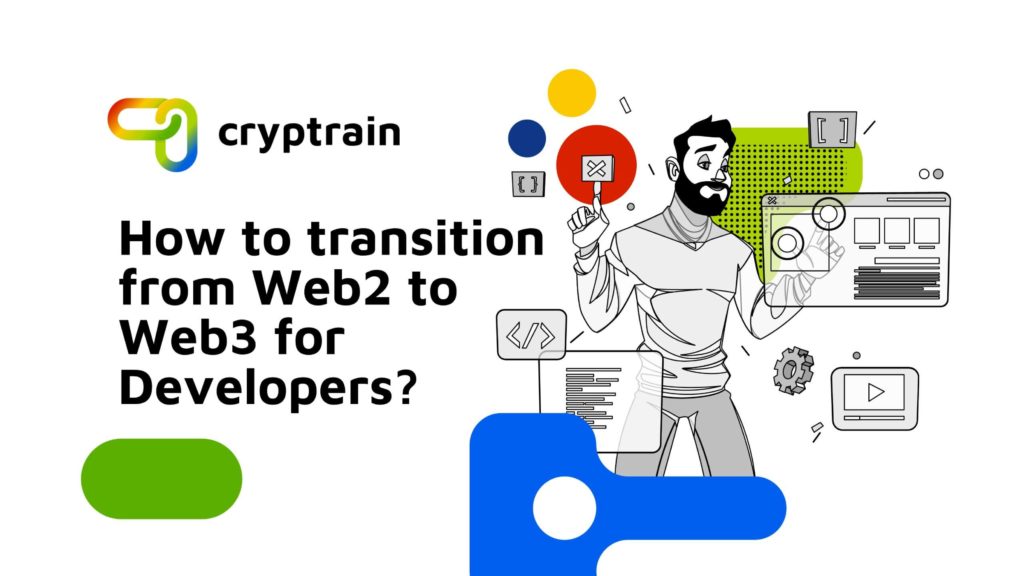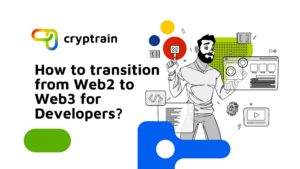
The evolution of Web2 to Web3 is one of the most significant changes to the ways in which developers and consumers design, deploy, and interact with online environments since the internet shifted from a static Web1 model to the interactive, dynamic internet we know today.
The new frontier of Web3 promises decentralization, blockchain-powered features such as instant access to NFT-based assets and tokenization, and crypto wallet integration. If you’re already working as a developer in the Web2 industry, determining exactly how to transition into Web3 and identifying which skills transfer over and which need to be learned can be a complicated process.
In this blog post, we’ll examine the differences between Web2 and Web3 and highlight the key skills required to transition from Web2 development to Web3 development.
What is Web3?
Web3 is defined by the evolution from centralized web architecture and design into a decentralized model. Web3 is primarily driven by blockchain technology and focuses on a new model of web interaction through which users retain sovereignty over their data and assets.
The core principle of Web3 is the creation of a new means of providing utility to both users and builders. Unlike Web2, in which centralized platforms, hosts, and service providers reap the benefits of service delivery without providing users with control, Web3 is collaborative, decentralized, and aims to share the benefits and potential of the internet with both users and providers.
Web3 platforms are typically built using decentralized architecture such as IPFS, Ethereum, Solana and Filecoin and range from blockchain-based decentralized applications (dApps) and DeFi protocols to completely decentralized web platforms and web wallets.
The key features of Web3 include:
- Decentralization: Web3 places control over information and assets in the hands of users.
- Immutability: The blockchain technology that drives Web3 is highly transparent, secure, and immutable, making it difficult for bad actors to tamper with data or information.
- Smart contracts: Blockchain-based smart contracts facilitate trustless agreements between Web3 users, facilitating the creation of decentralized applications, protocols, and services
- Privacy, Security, and Sovereignty: Web3 prevents data breaches through the use of complex encryption and cryptography
Interoperability: Web3 systems and protocols are designed to be interoperable, which is achieved through the use of open standards that allow data and value to flow freely through disparate platforms
What is the Difference Between Web2 and Web3?
Understanding what changes and what remains the same when shifting from Web2 to Web3 is critical when transitioning into Web3 development. While Web3 is fundamentally different at a protocol layer than traditional Web2 development, both Web2 and Web3 are, at a basic level, web services and platforms.
Developers familiar with UI development through React, for example, will find that it’s just as easy to create Web3 UIs as Web2 UIs. The most important difference between the two is how data and authentication is handled via Web3.
Rather than managing access tokens or passwords, for example, Web3 applications typically focus on handling signed messages and wallet connections that use blockchain technology. A blockchain wallet, in most cases, functions as an interoperable identity and value storage mechanism across multiple dApps.
Web3 services and platforms, unlike Web2 platforms, typically don’t make requests to centralized API servers. Instead, Web3 services, protocols, and platforms read data directly from a blockchain via smart contracts.
Data mutation is one of the most significant differences between Web2 and Web3, and can have a profound impact on user experiences. POST requests in Web2, for example, generally only take a few hundred milliseconds.
Blockchain calls and transactions via smart contracts on Web3, however, can take minutes or even hours. Altering data committed to a blockchain or mutating smart contract data also incurs a fee — the blockchain architecture that drives Web3 is fee-oriented and in many cases makes it impossible to alter data committed to the chain.
What Skills are Required for Web3 Development?
The Web3 ecosystem is a rapidly-changing landscape of blockchain networks, protocols, dApps, and developing technologies. As such, it’s necessary to foster a broad spectrum of skills in order to understand and implement the infrastructure and tools used to create Web3 platforms and services.
Blockchain & Smart Contract Development
The most important skill required to transition from Web2 development to Web3 development is a robust understanding of blockchain technology and smart contracts.
A Web3 developer must understand how blockchain networks work and how to interact with the smart contracts and dApps that run on them. Developers should also consider the new languages required to compose smart contracts on blockchain networks, such as Ethereum’s Solidity, as well as the importance of JS and React in interacting with blockchain protocols.
Front End Web Development
Blockchain technology and smart contracts may power the Web3 ecosystem, but it’s essential to develop an understanding of how Web3 services and platforms are delivered to users. The Web3 ecosystem is largely based on JS, so a deep understanding of Node, Next, and React is just as important in Web3 development as Web2 development.
If you’re already working in Web2 and possess experience with JS, diving into EtherJS or Web3JS is a highly effective way to gain immediate insight into front-end implementation in Web3.
Protocol and Market Knowledge
The Web3 ecosystem is evolving rapidly — keeping on top of changes and updates to the protocols most widely used within the Web3 industry and the development of new layers and forks to blockchain networks provides Web3 developers with the necessary insight to work on the cutting edge of Web3.
Remaining aware of and engaged in community discussions regarding new smart contract protocols, wallets, ID services, tokens, and decentralized autonomous organizations is essential when working in Web3.
Where to Find Web3 Developer Jobs
Finding a Web3 development role can be a time-consuming process — the Web3 development ecosystem is spread over so many different protocols, platforms, and ecosystems that finding the right role in the right Web3 vertical can often involve days of sorting through job listings.
Joining a talent pool, such as Cryptrain’s global talent pool for blockchain and Web3 developers, can provide next-generation Web3 devs with immediate access to an international network of employers and projects within the blockchain and Web3 industry.
Cryptrain’s AI-powered screening features leverage artificial intelligence to accurately assess and grade developer code, providing potential employers with actionable insight into how and where you specialize in the Web3 sector. If you’re currently seeking a role in the Web3 industry as a developer, join the Cryptrain global talent pool today.



